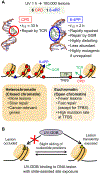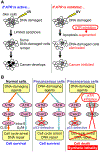Deciphering UV-induced DNA Damage Responses to Prevent and Treat Skin Cancer
- PMID: 32119110
- PMCID: PMC7651136
- DOI: 10.1111/php.13245
Deciphering UV-induced DNA Damage Responses to Prevent and Treat Skin Cancer
Abstract
Ultraviolet (UV) radiation is among the most prevalent environmental factors that influence human health and disease. Even 1 h of UV irradiation extensively damages the genome. To cope with resulting deleterious DNA lesions, cells activate a multitude of DNA damage response pathways, including DNA repair. Strikingly, UV-induced DNA damage formation and repair are affected by chromatin state. When cells enter S phase with these lesions, a distinct mutation signature is created via error-prone translesion synthesis. Chronic UV exposure leads to high mutation burden in skin and consequently the development of skin cancer, the most common cancer in the United States. Intriguingly, UV-induced oxidative stress has opposing effects on carcinogenesis. Elucidating the molecular mechanisms of UV-induced DNA damage responses will be useful for preventing and treating skin cancer with greater precision. Excitingly, recent studies have uncovered substantial depth of novel findings regarding the molecular and cellular consequences of UV irradiation. In this review, we will discuss updated mechanisms of UV-induced DNA damage responses including the ATR pathway, which maintains genome integrity following UV irradiation. We will also present current strategies for preventing and treating nonmelanoma skin cancer, including ATR pathway inhibition for prevention and photodynamic therapy for treatment.
© 2020 American Society for Photobiology.
Conflict of interest statement
Competing Interests: The authors declare no competing interests.
Figures










Similar articles
-
Major Roles for Pyrimidine Dimers, Nucleotide Excision Repair, and ATR in the Alternative Splicing Response to UV Irradiation.Cell Rep. 2017 Mar 21;18(12):2868-2879. doi: 10.1016/j.celrep.2017.02.066. Cell Rep. 2017. PMID: 28329680
-
Requirement for functional DNA polymerase eta in genome-wide repair of UV-induced DNA damage during S phase.DNA Repair (Amst). 2010 Jul 1;9(7):754-64. doi: 10.1016/j.dnarep.2010.03.013. Epub 2010 Apr 24. DNA Repair (Amst). 2010. PMID: 20457011
-
Solar UV damage to cellular DNA: from mechanisms to biological effects.Photochem Photobiol Sci. 2018 Dec 5;17(12):1842-1852. doi: 10.1039/c8pp00182k. Photochem Photobiol Sci. 2018. PMID: 30065996 Review.
-
Nucleotide Excision Repair and Vitamin D--Relevance for Skin Cancer Therapy.Int J Mol Sci. 2016 Apr 6;17(4):372. doi: 10.3390/ijms17040372. Int J Mol Sci. 2016. PMID: 27058533 Free PMC article. Review.
-
DNA damage responses in skin biology--implications in tumor prevention and aging acceleration.J Dermatol Sci. 2009 Nov;56(2):76-81. doi: 10.1016/j.jdermsci.2009.09.001. Epub 2009 Sep 24. J Dermatol Sci. 2009. PMID: 19781914 Review.
Cited by
-
Investigation on the Awareness and Behavior of Primary School Students on Sunscreen Use in Beijing.Clin Cosmet Investig Dermatol. 2022 May 16;15:887-894. doi: 10.2147/CCID.S365856. eCollection 2022. Clin Cosmet Investig Dermatol. 2022. PMID: 35601539 Free PMC article.
-
Immunohistochemical expression of p53, Ki67, α-SMA, CD44 and CD31 in different histological subtypes of basal cell carcinoma.Rom J Morphol Embryol. 2022 Apr-Jun;63(2):383-393. doi: 10.47162/RJME.63.2.09. Rom J Morphol Embryol. 2022. PMID: 36374143 Free PMC article.
-
Unveiling the interplay between mutational signatures and tumor microenvironment: a pan-cancer analysis.Front Immunol. 2023 May 22;14:1186357. doi: 10.3389/fimmu.2023.1186357. eCollection 2023. Front Immunol. 2023. PMID: 37283742 Free PMC article.
-
Decoding stimulus-specific regulation of promoter activity of p53 target genes.Front Cell Dev Biol. 2025 Jun 13;13:1603603. doi: 10.3389/fcell.2025.1603603. eCollection 2025. Front Cell Dev Biol. 2025. PMID: 40584962 Free PMC article.
-
Evidence for Involvement of Nonclassical Pathways in the Protection From UV-Induced DNA Damage by Vitamin D-Related Compounds.JBMR Plus. 2021 Sep 29;5(12):e10555. doi: 10.1002/jbm4.10555. eCollection 2021 Dec. JBMR Plus. 2021. PMID: 34950826 Free PMC article.
References
-
- Kwa RE, Campana K and Moy RL (1992) Biology of cutaneous squamous cell carcinoma. J Am Acad Dermatol 26, 1–26. - PubMed
-
- Albert MR and Ostheimer KG (2002) The evolution of current medical and popular attitudes toward ultraviolet light exposure: part 1. J Am Acad Dermatol 47, 930–937. - PubMed
-
- Armstrong BK, Kricker A and English DR (1997) Sun exposure and skin cancer. Australas J Dermatol 38 Suppl 1, S1–6. - PubMed
-
- Clydesdale GJ, Dandie GW and Muller HK (2001) Ultraviolet light induced injury: immunological and inflammatory effects. Immunol Cell Biol 79, 547–568. - PubMed
Publication types
MeSH terms
Substances
Grants and funding
LinkOut - more resources
Full Text Sources
Medical
Research Materials
Miscellaneous

